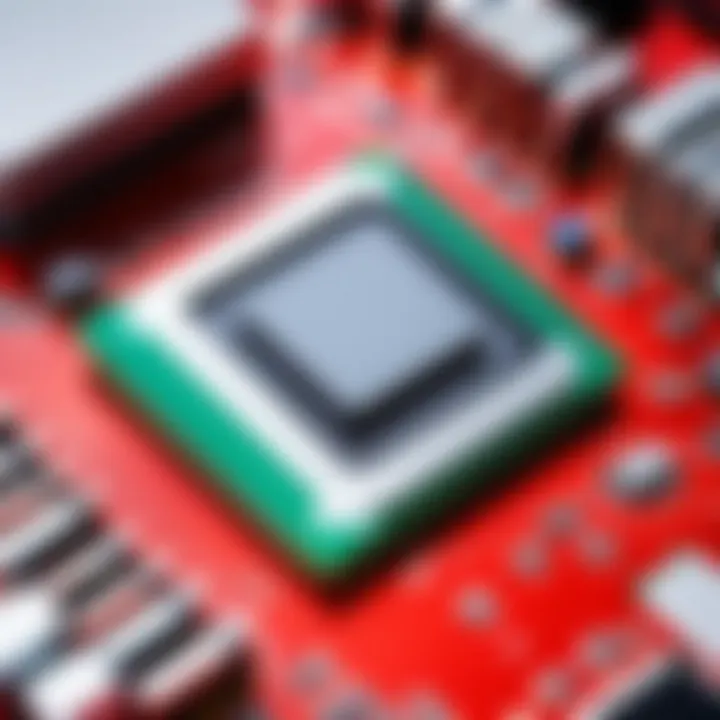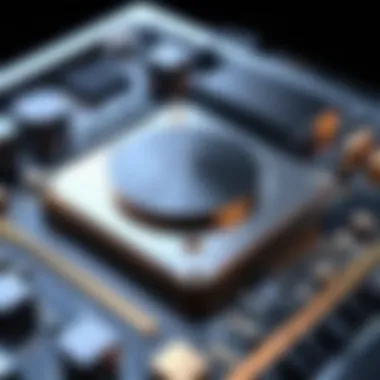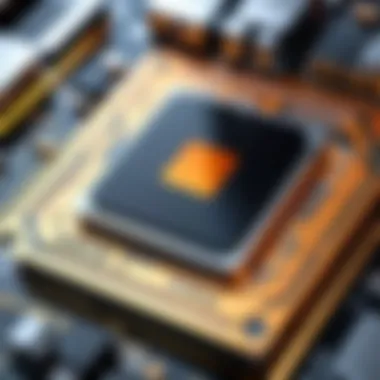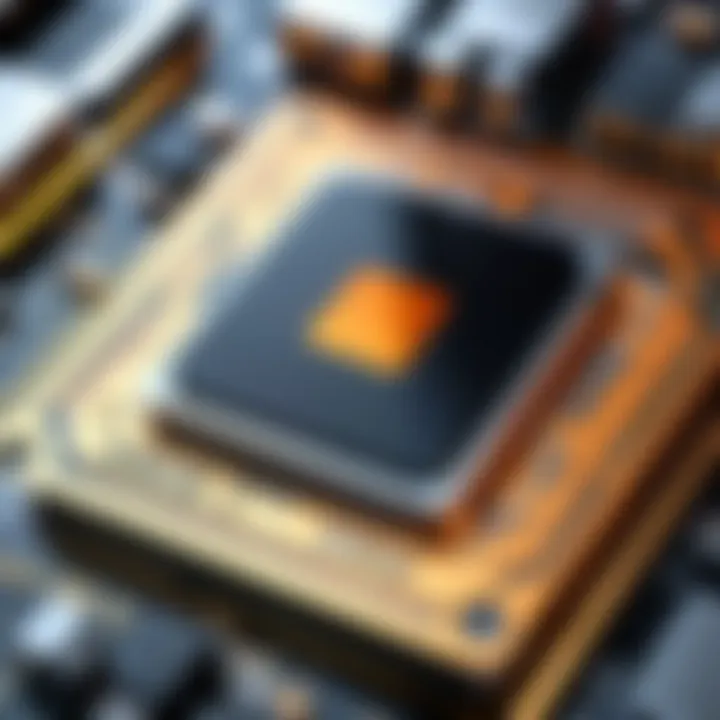Alternative Solutions to Thermal Paste in Computers


Intro
In the world of computer hardware, managing heat can literally make or break your system's performance. As technology evolves, so does the need for effective thermal management solutions. While traditional thermal paste has long been the go-to choice for enthusiasts and professionals alike, new alternatives are emerging that promise better results in cooling performance, application ease, and longevity.
This article will delve into a variety of these alternatives, weighing their advantages and pitfalls while shedding light on their practical applications in real-world scenarios. By examining various thermal interface materials, we aim to equip gamers, IT professionals, and tech aficionados with the knowledge necessary to make informed choices about their cooling solutions.
From silicone pads to liquid metals, each option has its own unique attributes and compatibility profiles. It’s essential to understand these differences in order to optimize your system for peak performance. Let’s dive into the details and explore the landscape of thermal management beyond the conventional thermal paste.
Understanding Thermal Interface Materials
Thermal interface materials, often called TIMs, play a crucial role in managing heat within computer systems. These materials ensure that there is efficient thermal transfer between a heat-producing component, like a CPU or GPU, and the cooling mechanism, which could be a heatsink or a fan. Understanding the nature of these materials is imperative for anyone looking to optimize the performance and reliability of their computer hardware.
Definition and Function
Simply put, thermal interface materials serve to bridge the gap between surfaces that need thermal contact. When components are manufactured, they don't fit perfectly together. Microscopic imperfections create small air pockets, and since air is a poor conductor of heat, those pockets hinder performance. Here’s where TIMs come into play. They fill those gaps, ensuring a more effective transfer of heat from the processor to the cooler.
Importance in System Performance
In computer hardware, the effective transfer of heat can dictate performance. A well-managed thermal interface not only allows components to run cooler but can also increase longevity and efficiency. For example, if a CPU runs significantly hotter due to inadequate thermal conductivity, throttling can occur. This is a self-protective mechanism where the processor reduces its speed to prevent damage from overheating. In essence, a good TIM ensures that your hardware performs at its best, avoiding the pitfalls of heat failures.
Thermal Conductivity Explained
Now, let’s talk thermal conductivity. This is the property that determines how well heat moves through a material. It’s generally measured in watts per meter-kelvin (W/m·K). Materials with high thermal conductivity, like silver, allow heat to pass through more efficiently compared to lower conductivity materials, like silicone rubber.
A few key points about thermal conductivity include:
- Material Choice: The type of TIM you choose can significantly affect system temperatures. Liquid metals, for instance, can have thermal conductivities as high as 80 W/m·K.
- Temperature Range: Different materials perform differently under various temperature conditions, so it's vital to consider the operating environment.
- Viscosity and Thickness: The application method can also affect the effectiveness of the TIM. Thicker layers may trap air and reduce performance, while too thin a layer might not provide adequate coverage.
"The right thermal interface can make the difference between a stable system and one teetering on the edge of failure."
Limitations of Traditional Thermal Paste
When it comes to maintaining optimal temperatures in computer hardware, traditional thermal paste has long been the go-to solution for many. Yet, it’s important to point out that it is not without its downsides. Understanding the limitations of thermal paste gives insight into why one might consider alternative materials for thermal management. Let's explore some critical weak points related to conventional thermal paste.
Degradation Over Time
One glaring drawback of thermal paste is its tendency to degrade over time. As components heat up, the paste can dry out, flake, or lose its effectiveness. This degradation can be catastrophic. Imagine a once-smooth layer that, over several months, turns into a cracked and crumbled mess. That breakdown can lead to poor heat transfer,both for CPU or GPU, causing them to overheat and even potentially damaging the hardware. What’s more, many users are oblivious to this issue until it’s too late. That's one reason for considering alternatives that have more robust longevity and better performance retention.
Application Challenges
Applying thermal paste can be an art as much as it is a science. Too little paste? You risk leaving gaps for air bubbles that ruin heat diffusion. Too much? You could potentially have a spillover that creates a messy situation, possibly leaking onto circuit boards and causing shorts. This delicate balance can overwhelm even seasoned builders. Several techniques exist, like the pea-sized dot or the spread method, but they aren't foolproof. The inconsistency speaks volumes for the need to find solutions that simplify the application process—one that would present fewer hurdles, especially for newcomers.
Environmental Impact
Thermal paste isn’t just thermally problematic; it also has environmental implications that can’t be ignored. Some traditional pastes contain materials that pose a risk to the environment during disposal or if mishandled. For instance, lead-based pastes could be hazardous if not disposed of properly. As society grows more concerned with sustainability, considering alternative thermal solutions that are environmentally friendly becomes even more pertinent. We live in times where innovations embrace not only performance but also ecological responsibility. Thus, alternatives could not only lessen thermal issues but would also align with a greener initiative.
"Recognizing the drawbacks of traditional thermal paste is the first step towards exploring better, more efficient solutions."
Each of these limitations beckons the need for alternatives that can traverse the pitfalls of traditional thermal paste. As we delve deeper into alternatives, acknowledging these weaknesses sharpens our focus on what to look for when considering next steps in thermal interface technology.
Alternative Materials Overview
The exploration of alternative thermal interface materials is crucial in today's tech-driven world as thermal management plays a pivotal role in optimizing performance and extending the lifespan of computer hardware. As systems become more powerful, the demand for effective cooling solutions has pushed enthusiasts and professionals alike to investigate beyond traditional thermal paste. Each substitute offers its benefits, and understanding these can help users make informed decisions tailored to their specific setups.
Liquid Metal Solutions
Usage in High-Performance Settings
Liquid metal solutions have been increasingly adopted in high-performance environments like gaming rigs and workstations that require exceptional thermal conductivity. This choice is primarily due to the superior heat dissipation capabilities of liquid metals, which can significantly reduce CPU and GPU temperatures compared to conventional thermal pastes. The key characteristic of these solutions is that they remain in liquid form, allowing for better conformance to surfaces, thus minimizing gaps that could hinder efficiency. However, while effective, the unique feature of liquid metals also lies in their conductivity, which can be a double-edged sword, necessitating careful handling to avoid short-circuits.
Conductivity Advantages
One of the most impressive aspects of liquid metal alternatives is their remarkable thermal conductivity, often exceeding 70 W/m·K. This high performance makes them an attractive option for those seeking to maximize their system's cooling efficiency. The distinctive quality of this material is its ability to transfer heat almost tenfold better than traditional paste. Consequently, users tend to favor this material in settings where maintaining lower temperatures can lead to increased performance and longevity. However, with great power comes responsibility, as ensuring proper application can be tricky.
Risks and Precautions


Despite their advantages, switching to liquid metal solutions entails certain risks. The primary concern revolves around conductivity, as mishandling can lead to inadvertent contact with electrical components, potentially causing a short circuit. Users must take precautions during application, including using non-conductive surfaces and tools. Another unique feature is that liquid metal can sometimes seep out from areas if not applied with precision, making cleanliness crucial.
Thermal Pads
Ease of Installation
Thermal pads have gained popularity due to their significant ease of use. Unlike traditional thermal paste, which often requires careful application to ensure even distribution, thermal pads can be simply placed between components, making them suitable for novices and professionals alike. The key characteristic here is the convenience they offer, eliminating the stress of getting the right application thickness. In many cases, users praise thermal pads for their straightforwardness, though careful package inspection is advised to ensure no flaws exist in the pad itself upon purchase.
Application Scenarios
Thermal pads excel in scenarios where a quick installation is necessary or in devices with tight space constraints. They can be applied to both processors and graphics cards, as well as other components that generate heat. This adaptability is a substantial advantage as it caters to various needs. However, they generally do not offer the same level of performance as higher-end thermal pastes or liquid metals, making them a compromise in terms of thermal conductivity.
Performance Limitations
While thermal pads provide several benefits, they also come with performance limitations. Typically, their thermal conductivity can range between 2-5 W/m·K, which may not suffice in demanding applications, such as overclocking. This drawback is significant for users who aim to push their systems to the max, so it is essential to weigh priorities when considering thermal pads for high-demand hardware.
Graphene-Based Solutions
Emerging Technologies
Graphene-based thermal interface materials are one of the latest breakthroughs in cooling technology. These materials have gained attention due to graphene's exemplary thermal conductivity, which is around 5300 W/m·K. The key characteristic of this technology lies in its potential as a lightweight yet powerful thermal conductor. Although still largely in the research phase and not widely available for consumer use, the findings suggest great promise for future applications in computer hardware, pointing towards a leap forward in thermal management solutions.
Potential Benefits
The potential benefits of graphene thermal materials are vast. They could drastically improve thermal performance while reducing weight in devices, making them an appealing choice for laptops and compact systems where space is at a premium. A unique feature of this technology is its high durability and thermal stability, suggesting longevity even under intense operational conditions. While these materials are currently more theoretical than practical, their anticipated benefits draw attention and investment.
Current Market Availability
Currently, graphene-based thermal solutions are not widely available in the consumer market. Their emerging nature means that development continues in labs rather than on retail shelves. This reality poses a challenge for early adopters eager to implement cutting-edge technology. For those who keep an eye out for innovations, monitoring advancements in graphene technology could yield exciting opportunities as the market evolves.
Phase Change Materials
Mechanism of Action
Phase change materials (PCMs) are unique in their ability to absorb and release thermal energy as they transition between solid and liquid states. This characteristic allows them to maintain a stable temperature for extended periods, acting as a heat buffer. The key trait of PCMs lies in their ability to stabilize temperatures under varying load conditions, making them particularly useful in environments where large thermal fluctuations may occur. Users can find this feature especially beneficial for high-performance computing where consistent temperatures are vital.
Applications in Cooling Systems
PCMs are versatile and find applications in various cooling systems, from CPU/GPU setups to wider electronic enclosures where heat dissipation is critical. Their adaptability makes them a valuable resource for temperature control. Some products can even be integrated into the design of devices, providing passive cooling without requiring active intervention. However, proper integration is essential to maximize their effectiveness, bringing forth challenges in optimizing performance.
Effectiveness Compared to Paste
When comparing PCMs to traditional thermal pastes, they often provide comparable or superior performance in specific scenarios. Their unique behavior during phase transitions can lead to better thermal regulation than paste alone. However, the trade-off is that their effectiveness can diminish when temperatures exceed designed thresholds. Evaluating your specific application's needs will aid in deciding if PCMs are a wise alternative.
Conductive Adhesives
Strong Bonding Characteristics
Conductive adhesives provide excellent thermal transport while also serving as a bonding agent. This dual functionality can be advantageous in applications requiring interconnections between heat-producing components and heat sinks. Their key characteristic is this hybrid capability, which allows tighter assembly and improved thermal performance where minimal space is available. However, achieving the right balance in application is necessary to avoid excess material, which can lead to issues.
Usage Scenarios
These adhesives are suitable for a range of scenarios, including connecting heat sinks to chips as well as adhering components on PCBs. They tend to shine in environments where flexibility in design is needed, making them beneficial for creating intricate assemblies. However, users should note that while they bond well, they might not match pure thermal pastes in terms of thermal conductivity.
Performance Insights
From a performance standpoint, conductive adhesives often create effective thermal paths but do not outperform specialized thermal materials in high-demand situations. Their unique feature, however, is their combined ability to hold components together while also managing heat, providing a practical solution for lower-performance applications. Users should carefully consider their cooling requirements before opting for conductive adhesives to ensure they are making the best choice for their setup.
Understanding alternative thermal interface materials is key to optimizing your computer hardware's performance. As technology advances, staying informed enables you to make better decisions, tailoring your setup to your specific needs.
Performance Comparison
When diving into the realm of thermal interface materials, performance comparison becomes a pivotal topic. For anyone involved with building or maintaining computers, understanding how different materials stack up against one another can literally be the difference between smooth performance and catastrophic failure. Performance comparison not only highlights the efficiency of these alternatives but also sheds light on their long-term viability and cost-effectiveness.
Choosing the right thermal material is akin to fitting the right pieces into a puzzle. If it’s not done strategically, the entire picture gets muddled. For example, the thermal management of a high-end gaming rig could benefit immensely from materials that showcase superior thermal conductivity. Thus, the comparative performance metrics can guide users in selecting solutions that cater directly to their specific needs.


Thermal Conductivity Tests
At the heart of any performance comparison lies thermal conductivity tests. Understanding this property allows users to measure how effectively different materials can transfer heat. In practical terms, higher thermal conductivity correlates with better heat dissipation, leading to cooler components.
Various materials exhibit different thermal conductivity ratings. Liquid metal solutions, like Thermal Grizzly Conductonaut, can achieve thermal conductivities up to 73 W/m·K, far surpassing traditional silicone-based pastes, which often hover around 0.25 to 5 W/m·K. Such stark differences underscore why these tests are critical for users looking to overclock their CPUs or GPUs.
It’s also useful to hold these tests to rigorous methods, such as using an infrared camera to measure temperature distribution across a heat sink. This level of analysis helps confirm not just how each material performs, but also under what circumstances they excel or falter.
Real-World Application Scenarios
Theoretical insights from thermal conductivity tests are one thing, but how do these materials behave in the real world? Application scenarios provide a clearer picture. In a gaming scenario, for instance, high demands on the CPU and GPU can lead to thermal throttling if not managed effectively; hence, optimal thermal interface materials are crucial.
Cooling solutions must suit not just the hardware specifications but also the conditions in which they operate. For example, a workstation used for rendering might cope with prolonged heavy loads, making liquid metal an apt choice due to its superior heat transfer properties. On the other hand, thermal pads could shine in setups where ease of installation and maintenance are key factors. The adaptability of these materials in various contexts is a significant consideration.
User feedback also plays a vital role. Enthusiast communities on platforms like Reddit often share firsthand experiences, discussing how certain materials performed under stress during lengthy gaming sessions or intensive computational tasks.
Durability and Lifespan
No material is worth considering without assessing its durability and lifespan. After all, the initial performance might be impressive, but if a solution fails shortly after application, it becomes a costly error.
Traditional thermal pastes are notorious for degrading over time, with many breaking down within a year or two under the right conditions. In contrast, conductive adhesives and high-end thermal pads often boast longer lifespans, sometimes exceeding five years. Their resistance to degradation places them in a favorable light for users involved in long-term computing tasks.
Furthermore, resistance to environmental factors like humidity and temperature fluctuations can greatly influence longevity. Some materials might perform well under controlled conditions but fall short in real-world environments.
In summary, a thorough performance comparison across different alternatives to traditional thermal paste brings essential insights to light. Evaluating their thermal conductivity through rigorous tests, understanding their behavior in real-world applications, and examining their durability grants users a clearer path to making informed decisions in thermal management.
Cost Analysis of Alternatives
In the quest for optimal thermal management in computer hardware, it's not just about the raw performance of alternative materials. Understanding the financial implications of these options is equally paramount. Cost analysis sheds light on the best choices available while aligning with the user's budget and performance requirements. When considering alternatives to thermal paste, factors like initial expense, long-term savings, and overall efficiency come into play, ensuring that the selected material not only performs well but also fits the economic narrative.
Price Comparison Across Materials
Finding the right temperature-regulating solution typically starts with a price check. Each alternative comes with its unique price tag, reflecting material properties, manufacturing complexity, and intended application. Here’s a snapshot of how these alternatives may stack up:
- Liquid Metal Solutions: Generally, these solutions command a higher price due to their superior conductivity and potential for performance gains. Brands like Thermal Grizzly Conductonaut are noted for their efficacy but may come at a cost of around $30 for a small tube.
- Thermal Pads: Often found at lower price points, thermal pads range from $5 to $20, depending on thickness and quality. Their ease of use and installation can save time, even if their thermal efficiency might lag behind liquid metals.
- Graphene-Based Solutions: Being a newer player, graphene’s pricing is in flux. While some products may be competitive, premium brands could go upwards of $50 due to advanced technology.
- Phase Change Materials: As a growing trend, prices can vary, but typically they fall within the $10 to $30 bracket, making them accessible options for many users.
- Conductive Adhesives: These often combine thermal efficiency with bonding strength, with prices ranging from $15 to $40.
In summary, it’s crucial to perform a side-by-side comparison, considering not just the initial outlay but also the expected performance returns.
Long-Term Investment Considerations
When assessing thermal interface materials, it’s not only about what you spend upfront, but also what you might save over time. If you buy cheaper alternatives, you might face higher replacement costs or reduced efficiency, which can ultimately affect your hardware's performance and lifespan. Here are some thoughts to ponder:
- Durability: Investing in higher-quality materials like liquid metals might mean fewer replacements required over time, reducing cumulative costs.
- Energy Efficiency: Materials that better manage heat can lead to a less burdened cooling system, which ultimately translates to lower energy consumption. This could mean noticeable savings on your electricity bill.
- Performance Longevity: Components maintained at optimal temperatures can function better for longer, potentially staving off the need for replacements or repairs due to overheating.
"Choosing the right thermal interface material can be akin to selecting the right security system for your home; it’s an upfront cost with long-term peace of mind."
Ultimately, conducting a thorough cost analysis helps in understanding the balance between quality and expense. This way, not only can tech enthusiasts make informed purchase decisions, but they can also ensure that their investments result in sustained performance. As the landscape shifts and new materials emerge, the ongoing analysis of costs and benefits remains paramount.
Ease of Application and User Experiences
When it comes to maintaining a computer's thermal management system, the ease of application and user experience can’t be overlooked. Many tech enthusiasts often prioritize performance through sheer statistics, yet, the practical aspect of applying thermal interface materials plays just as crucial a role. The wrong choice here can lead to sloppy application or even damage to components, leading to frustrating experiences. That's why making informed choices can pave over potential pitfalls.
User Reviews across Various Alternatives
User reviews can be a goldmine for insights into how these alternatives perform under different circumstances. For instance, liquid metal solutions have been praised for their remarkable conductivity. However, some users have pointed out the challenges involved with applying it correctly and the risk of damaging components if it spills over. On the other hand, thermal pads often receive accolades for their simplicity. Many users appreciate being able to just stick them in place without the worry of precision. Yet, their thermal performance can sometimes fall short compared to paste or liquid metals.
- Liquid Metal Reviews
Pros: Excellent thermal conductivity, lightweight.
Cons: Risky application, potential spills. - Thermal Pad Reviews
Pros: Easy installation, generally mess-free.
Cons: Lower thermal efficiency compared to liquid options.
While grappling with these reviews, one must recognize patterns. It's commonplace to find users expressing satisfaction in materials that strike the balance between performance and ease of use. For example, graphene-based solutions are gaining traction due to their innovative nature coupled with positive feedback about user application experiences.
Practical Tips for Application
A seamless application process can make or break the experience. Here are some practical tips for anyone venturing into applying these thermal interface materials:
- Read the Instructions Thoroughly:
Every product differs. Take a moment to familiarize yourself with specific requirements for the material you choose. - Gather the Right Tools:
Use a scraper or spatula designed for the purpose. Having the right tools on hand avoids mess and uneven application. - Surface Preparation is Key:
Clean your surfaces thoroughly with isopropyl alcohol to remove dust or residue. A clean surface ensures optimal thermal transfer. - Apply the Right Amount:
Less is often more. An excessive amount can lead to spillage and inefficient heat transfer. Remember, the goal is a thin, even layer. - Follow Best Practices:
For thermal pads, do not compress them too hard. For liquid metals, a slight pressure will help, but no more than necessary.


These steps can significantly ease the process and provide better results, helping users get the maximum benefits from whatever alternative they choose to employ. Ultimately, the takeaway is that selecting the right thermal interface material shouldn’t just hinge on its specifications, but also on how easy it is to use. User experience matters, and it can dramatically influence the effectiveness of your thermal management efforts.
Future Trends in Thermal Interface Technology
The arena of thermal interface materials (TIMs) is evolving rapidly. With the constant advancement in technology, the demand for more efficient thermal management solutions is only increasing. Not only do manufacturers seek to enhance performance, but they are also exploring sustainable options that align with modern ecological standards. The significance of this section lies in understanding innovative techniques that can push the boundaries of traditional materials, improve cooling efficacy, and ultimately contribute to system longevity.
Innovative Advancements
Recent breakthroughs in materials science have paved the way for an array of innovative TIMs that promise enhanced performance. Liquid metals, for instance, stand tall in the spotlight thanks to their remarkable thermal conductivity properties, outperforming conventional thermal pastes. The ability of these metallic compounds, such as gallium-based alloys, to fill microscopic crevices between surfaces establishes a more effective thermal connection, thus reducing thermal resistance significantly.
Other noteworthy advancements include the development of thermally conductive polymers. These materials can combine ease of application with respectable thermal performance. Hybrid solutions that incorporate nano-particles, like graphene, offer improved conductivity without compromising weight—a crucial factor for gaming and IT hardware where efficiency is paramount.
Moreover, phase change materials, which shift their state based on temperature fluctuations, are opening new doors in cooling technology. Their ability to absorb and dissipate heat without needing constant refreshment makes them particularly appealing for high-demand applications.
"Innovation in thermal management technologies can potentially double the lifespan of computer hardware."
Market Predictions
As companies scout for efficient solutions, market predictions suggest an upward trend in the adoption of alternative TIMs. Analysts forecast a burgeoning demand for liquid metals and graphene-based materials due to the increasing popularity of high-performance computing and gaming setups. Enterprises are likely to invest in these materials as they provide competitive advantages—about 60% faster cooling compared to traditional methods.
In contrast, traditional thermal pastes may begin to take a back seat, particularly in premium products. An expected 15% shift in the market in favor of advanced thermal solutions is on the horizon. The increasing consumer awareness about performance efficiency and long-term costs will only enhance this transition.
Furthermore, as we anticipate regulatory changes favoring sustainable practices, materials that offer both high performance and eco-friendliness are expected to perform exceptionally well. Brands that can marry efficiency with sustainability are poised to thrive in this evolving landscape.
Practical Recommendations
When it comes to optimizing the thermal management of your computer hardware, the importance of practical recommendations cannot be overstated. This section aims to guide tech enthusiasts, gamers, and IT professionals through the maze of alternatives to traditional thermal paste. Choosing the right thermal interface material can have significant implications for both performance and longevity of your system. Therefore, having a firm grasp of how to select and apply these alternatives properly is essential to achieving the best results.
Choosing the Right Alternative for Your Setup
Selecting the appropriate thermal interface material requires a clear understanding of your unique needs and the specifications of your hardware. Factors to consider include:
- Use Case: Are you an avid gamer, or do you use your setup for more heavy-duty tasks like rendering video? High-performance systems often benefit more from advanced alternatives like liquid metal.
- Compatibility: Certain materials work better with specific types of hardware. For instance, some liquid metal solutions may not be suitable for aluminum heatsinks due to corrosion concerns.
- Thermal Efficiency: Evaluate the thermal conductivity ratings of alternatives. Liquid metal tends to offer superior conductivity compared to thermal pads or traditional paste.
- Ease of Application: Some alternatives, like thermal pads, are user-friendly and can be applied with less technical know-how. On the other hand, liquid metal demands meticulous application techniques to avoid spills and ensure complete coverage.
Ultimately, it boils down to what fits your system's requirements without causing headaches during setup. It can be tempting to go with the shiniest new product on the market, but practical functionality should be the guiding principle.
Best Practices for Application
The effectiveness of any thermal interface material largely hinges on how well it’s applied. Below are some best practices to keep in mind:
- Surface Preparation: Cleanliness is paramount. Ensure that surfaces are free from dust, oils, or old thermal compound. A clean surface allows better adhesion and conductivity. Use isopropyl alcohol and a lint-free cloth for a thorough clean.
- Correct Amount: The adage "less is more" applies here. Overapplication can lead to spillage or uneven spread, compromising thermal conductivity and potentially causing damage. A small pea-sized dot in the center of the CPU or GPU is generally sufficient.
- Proper Pressure: After applying your chosen thermal material, use the appropriate pressure when seating the heatsink. This helps to spread the material evenly without running the risk of air bubbles.
"A well-prepped surface and a careful application can make all the difference in temperature management, extending the life of your components."
- Curing Times: If you choose a phase change material or certain adhesives, remember that some may need time to settle in. Consult the product guidelines to understand how long you should wait before putting the system under load.
In summary, practical recommendations are not just a suggestion but a map guiding you toward optimal thermal management. With the right choice of materials and their application, you can ensure that your system performs efficiently and reliably.
Finale
As we draw the curtain on this exploration of thermal management materials, it becomes clear that the discussion about alternatives to traditional thermal paste is not merely a technical one; it encompasses broader implications for performance, cost, and user experience in computer hardware. The quickly evolving landscape of thermal interface materials emphasizes the necessity of staying informed and adaptable in a field where efficiency is paramount.
One of the standout elements in this analysis is the recognition that materials such as liquid metal, thermal pads, and graphene offer distinct characteristics that can be tailored to fit specific use cases. The choice of material can significantly influence not just the silicon chips' temperature but also the overall longevity and reliability of the hardware. Choosing the right thermal solution ultimately leads to enhanced system performance and can mean the difference between a machine that runs hot and one that operates smoothly under pressure.
Considering the environmental footprint of these materials also requires attention. As we lean toward sustainable practices, understanding not only their performance but also their impact on our planet is essential.
An important aspect here is the ease of application. User experiences reveal that not all alternatives to thermal paste offer the same level of user-friendliness. Knowing the right practices can enhance the effectiveness of the application and ensure optimal performance from these substitutes.
In the grand scheme, the future of thermal management in computer hardware looks promising with innovative advancements on the horizon, paving the way for new materials and technologies that aim to better the interaction between components. The key to harnessing these benefits lies in keeping the lines of communication open between manufacturers, users, and technology enthusiasts, fostering a community that not only shares insights but collectively advances the standards of thermal interface technology.
Summary of Key Points
- The significance of thermal management in computing cannot be overstated; efficient cooling is integral to performance.
- Liquid metal, thermal pads, graphene, phase change materials, and conductive adhesives each present their own advantages and challenges.
- Ease of application varies widely among these alternatives, impacting user satisfaction and overall effectiveness.
- Future trends indicate a shift toward more innovative and efficient thermal materials that could reshape cooling methodologies.
The Future of Thermal Management
Looking ahead, the future of thermal management is brewing with potential innovations that might redefine our expectations. As technology marches on, we can expect some key trends:
- Increased Adoption of Liquid Metals: With their unparalleled thermal conductivity, liquid metals may become mainstream, emphasizing safety measures for users.
- Graphene Advancements: As research into graphene continues, we anticipate a surge in products leveraging this wonder material, delivering profound performance enhancements.
- Sustainable Options: There’s likely to be a greater focus on eco-friendly materials as the technology community grows more conscious of environmental impacts and sustainability.
- Automation in Application: Techniques and tools that ease application could democratize access to high-performance alternatives, ensuring more users can benefit from advanced cooling technologies.
Ultimately, continuous education and discussion within the tech community will propel future advancements in thermal management. The journey is ongoing, and each new discovery contributes not just to individual hardware performance, but to the evolution of technology as a whole.







